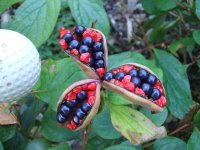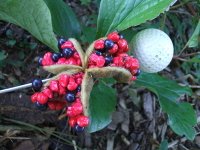 In a departure from the recurrent theme of essential autumn flowers, today features a plant that shouldn't normally bloom in fall (and for me, it rarely blooms at all). Well, at least the wet cool June and cooler than usual summer has benefitted something...
In a departure from the recurrent theme of essential autumn flowers, today features a plant that shouldn't normally bloom in fall (and for me, it rarely blooms at all). Well, at least the wet cool June and cooler than usual summer has benefitted something...Rhododendron impeditum is a wee gem of a subshrub from the mountains of western China near Tibet (apologies to those who find that a statement rife with politics, but my mind is kind of stuck with geography as taught in the 60's), on alpine meadows and open slopes at 9-16 thousand feet elevation. In the wild it can apparently reach a height of 3 feet, but in cultivation is more like 1 foot, which makes me feel a lot better about this plant of mine. It has been in this bed for 16 years now, and is still pretty miniscule; still, better than the others of the same batch which I sited in a few different locations-- they've all expired long since.
 If one looks closely on the first photo, one can make out a few buds which never opened; winter kill of most of the buds is a problem here most years, but this year apparently there was some early bud set, and autumn conditions were right for a few to open out of season.
If one looks closely on the first photo, one can make out a few buds which never opened; winter kill of most of the buds is a problem here most years, but this year apparently there was some early bud set, and autumn conditions were right for a few to open out of season.But, flowers or none, it has a nice foliage.



































 Carpels of Paeonia anomala subsp intermedia
Carpels of Paeonia anomala subsp intermedia












